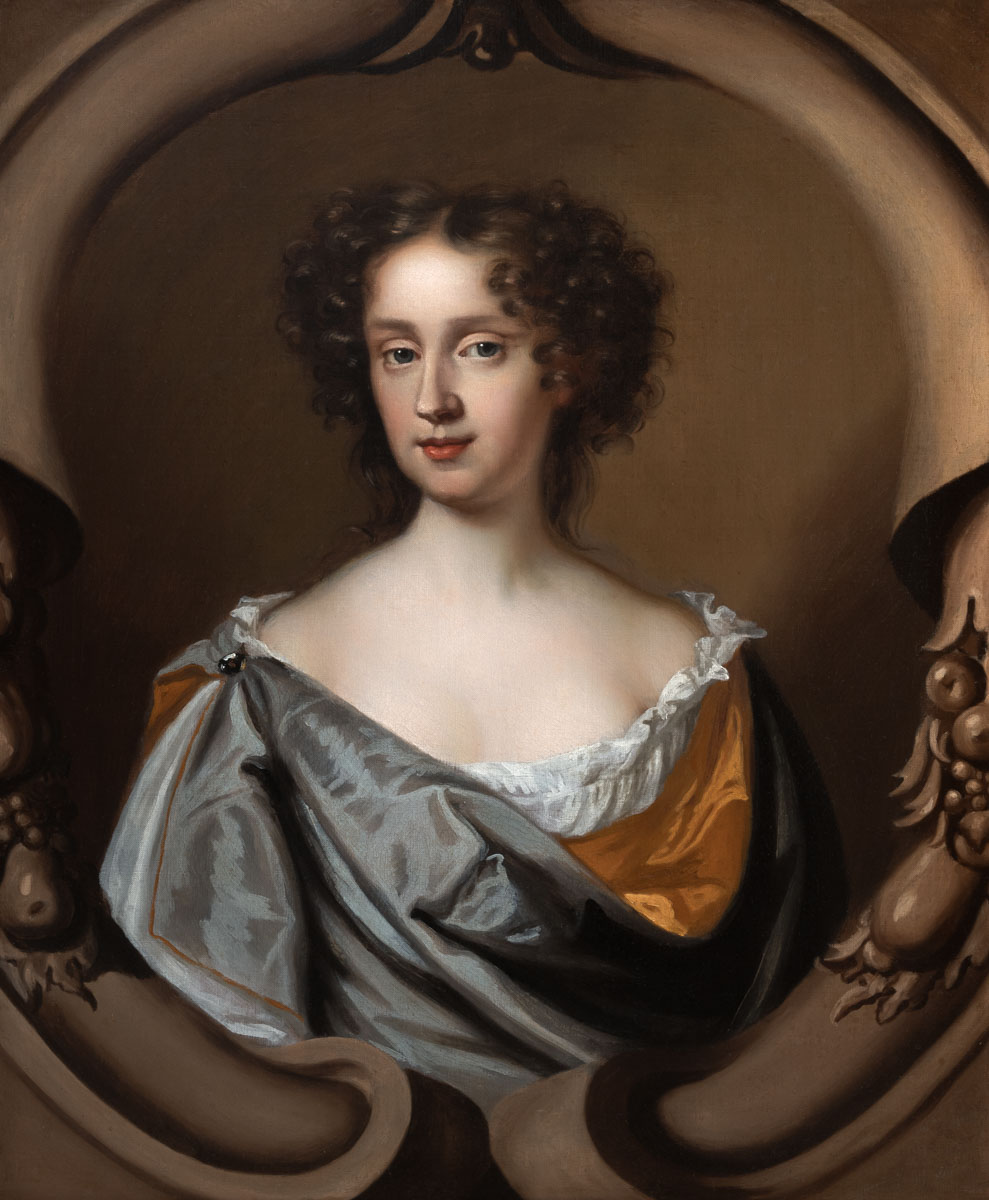Portrait of a Lady in an Elaborate Stone Cartouche c.1675-80
Mary Beale (1632-1699)
In this superb portrait the sitter has been portrayed wearing a low-cut white chemise under a gold silk robe with a draped light blue silk cape gathered at her left shoulder by a jewelled brooch. Her long brown hair is tied at back of neck and falls in loose curls about the face. The work was painted by Mary Beale, who was one of the first female portrait painters in England; today she enjoys a particular celebrity among the portraitists of the seventeenth century. This is not solely because she was a woman in a profession dominated by men, indeed, she was not alone in this: in “The Excellent Art of Painting” written in 1658 Sir William Sanderson records Mrs Beale among four named women painters practising in London. Rather it is because she competed so successfully with her colleagues, and was so prolific a painter: Additionally, through the diaries kept by her husband Charles, a former Clerk to the Patents Office, who became her studio assistant and colourman, we know more of her technique and working practice than that of any of her contemporaries, including Sir Peter Lely, and this has provided to historians today an invaluable record, unrivalled for the period, into the working life of an artist and their studio. Charles and Mary, together shared a passion not only for painting, but also the research of all the technical aspects behind its production. Whilst Mary executed the portrait commissions, Charles studiously experimented with pigments, mediums, canvases, and other materials that Mary needed'. His goal was to produce the finest materials and methods, at the most effective cost for Mary.
The precise details of Mary Beale's training remain obscure: her father John Craddock had been a member of the Painter-Stainers' Company, and had had his portrait painted by Robert Walker in the late 1640s. Walker was then pre-eminent among painters in London, particularly in the puritan circles that included Mary Beale's family, and it is, not unreasonably, supposed that Walker was her tutor in painting. In 1651 she married Charles Beale, a member of a prosperous family of Puritan gentry from Walton. Three years later their first son Bartholomew was born. Shortly afterward the painter and her family moved to Covent Garden, and began to associate with an erudite circle of artists, intellectuals and to clergymen that was to provide the base of her patronage in later years.
Initially, through his lucrative position at the Patent's Office, Charles was the main provider of the family's income. However, in 1665, with the Great Plague sweeping London and Charles losing his job, the Beales relocated from the city and took refuge at Albrook, a small village Hampshire. It was not until 1670, when she returned to London and their studio in Pall Mall, that she began her professional career in earnest. Our portrait, painted half-length set within a richly ornate faux cartouche surround, typical of the ‘Lelyesque’ design that was at the height of fashion at the time, probably dates from these first years in practice (this is further supported by the clothing and hairstyle). Sir Peter Lely (1618-1680), as Court Painter to Charles II and the most influential painter of the day, was an artist whom Mary and Charles both deeply admired. They worked hard to become acquainted with him and eventually succeeded in gaining the famous painter's friendship, support and encouragement. She and her sons had access to Lely’s fine collections, and she was permitted (no doubt a rare privilege) to observe him in the actual act of painting.
The style of portraiture which Peter Lely had made fashionable had been imitated by Mary in order to attract as wide a clientele as possible. Following his death in 1680 she continued to receive commissions for copies of his works, and made some attempt to keep abreast of current fashions, and this can be seen in her new and more relaxed postures, and she virtually abandoned the ornamental framing ovals which had characterised her head and shoulder portraits over the previous decade.
Traditionally, our portrait was thought to represent Louise de Kérouaille Duchess of Portsmouth, Charles II's favourite mistress, but the physiognomy of our sitter is incongruous with that of Louise de Kerouaille; the traditional assertion seems unlikely. The sitter bears a very striking resemblance to Catherine Sedley, Countess of Dorchester (1657-1717), Mistress of James II, wife of 1st Earl of Portmore, whom Lely painted circa 1675 - the same time as ours - and both sitters are about the same age.
The portrait is an exquisite example of Beale’s work at a time when she was producing some of her best work. Held in a fine period gilded frame.
Measurements: Height 90cm, Width 78cm framed (Height 35.5”, Width 30.75” framed)
£ 9,950
€ 11,650 (EU market only)
$ 12,250 (US market only)
Mary Beale (1632-1699)
In this superb portrait the sitter has been portrayed wearing a low-cut white chemise under a gold silk robe with a draped light blue silk cape gathered at her left shoulder by a jewelled brooch. Her long brown hair is tied at back of neck and falls in loose curls about the face. The work was painted by Mary Beale, who was one of the first female portrait painters in England; today she enjoys a particular celebrity among the portraitists of the seventeenth century. This is not solely because she was a woman in a profession dominated by men, indeed, she was not alone in this: in “The Excellent Art of Painting” written in 1658 Sir William Sanderson records Mrs Beale among four named women painters practising in London. Rather it is because she competed so successfully with her colleagues, and was so prolific a painter: Additionally, through the diaries kept by her husband Charles, a former Clerk to the Patents Office, who became her studio assistant and colourman, we know more of her technique and working practice than that of any of her contemporaries, including Sir Peter Lely, and this has provided to historians today an invaluable record, unrivalled for the period, into the working life of an artist and their studio. Charles and Mary, together shared a passion not only for painting, but also the research of all the technical aspects behind its production. Whilst Mary executed the portrait commissions, Charles studiously experimented with pigments, mediums, canvases, and other materials that Mary needed'. His goal was to produce the finest materials and methods, at the most effective cost for Mary.
The precise details of Mary Beale's training remain obscure: her father John Craddock had been a member of the Painter-Stainers' Company, and had had his portrait painted by Robert Walker in the late 1640s. Walker was then pre-eminent among painters in London, particularly in the puritan circles that included Mary Beale's family, and it is, not unreasonably, supposed that Walker was her tutor in painting. In 1651 she married Charles Beale, a member of a prosperous family of Puritan gentry from Walton. Three years later their first son Bartholomew was born. Shortly afterward the painter and her family moved to Covent Garden, and began to associate with an erudite circle of artists, intellectuals and to clergymen that was to provide the base of her patronage in later years.
Initially, through his lucrative position at the Patent's Office, Charles was the main provider of the family's income. However, in 1665, with the Great Plague sweeping London and Charles losing his job, the Beales relocated from the city and took refuge at Albrook, a small village Hampshire. It was not until 1670, when she returned to London and their studio in Pall Mall, that she began her professional career in earnest. Our portrait, painted half-length set within a richly ornate faux cartouche surround, typical of the ‘Lelyesque’ design that was at the height of fashion at the time, probably dates from these first years in practice (this is further supported by the clothing and hairstyle). Sir Peter Lely (1618-1680), as Court Painter to Charles II and the most influential painter of the day, was an artist whom Mary and Charles both deeply admired. They worked hard to become acquainted with him and eventually succeeded in gaining the famous painter's friendship, support and encouragement. She and her sons had access to Lely’s fine collections, and she was permitted (no doubt a rare privilege) to observe him in the actual act of painting.
The style of portraiture which Peter Lely had made fashionable had been imitated by Mary in order to attract as wide a clientele as possible. Following his death in 1680 she continued to receive commissions for copies of his works, and made some attempt to keep abreast of current fashions, and this can be seen in her new and more relaxed postures, and she virtually abandoned the ornamental framing ovals which had characterised her head and shoulder portraits over the previous decade.
Traditionally, our portrait was thought to represent Louise de Kérouaille Duchess of Portsmouth, Charles II's favourite mistress, but the physiognomy of our sitter is incongruous with that of Louise de Kerouaille; the traditional assertion seems unlikely. The sitter bears a very striking resemblance to Catherine Sedley, Countess of Dorchester (1657-1717), Mistress of James II, wife of 1st Earl of Portmore, whom Lely painted circa 1675 - the same time as ours - and both sitters are about the same age.
The portrait is an exquisite example of Beale’s work at a time when she was producing some of her best work. Held in a fine period gilded frame.
Measurements: Height 90cm, Width 78cm framed (Height 35.5”, Width 30.75” framed)
£ 9,950
€ 11,650 (EU market only)
$ 12,250 (US market only)












